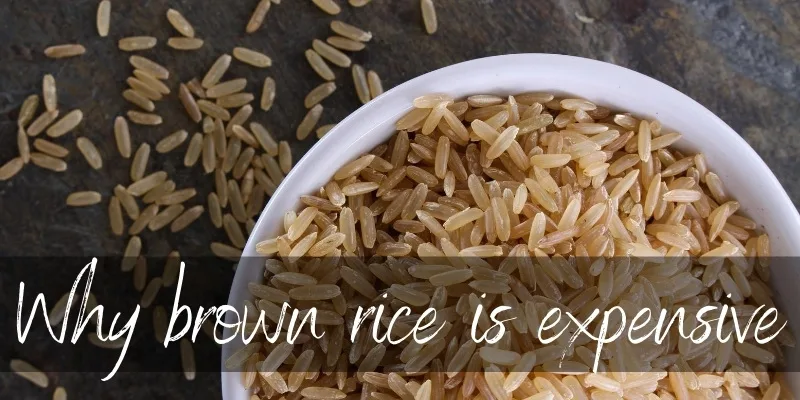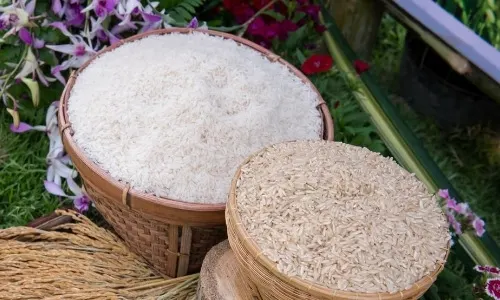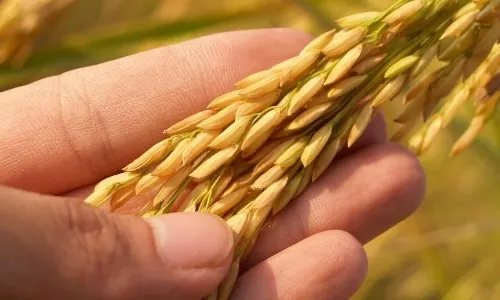Rice is a staple in many kitchens, be it white rice or brown or wild or a mix of all three.
What’s amazing is that for some reason, brown rice seems to be more expensive than white rice. Despite being the same food item in essence.
So why is that, why is brown rice more expensive than white rice ?
Well, after a bit of digging we’ve found some solid answers. They shed a whole new light on this everyday grain, and prove a lot of context.

Rice: from plant to your plate
First, to really set the context we need to look at what white and brown rice really are.
Understanding a grain of rice’s journey from the rice paddy all the way to your plate will really explain a lot, so here we go. We’ll try and keep this short.
So when rice is ready to be harvested, it looks like any other grain on this earth. Golden brown, maybe a bit paler, and easy to mistake for something else.
Rice has three layers. The outer layer, the husk, is always discarded. There’s not much you can do with rice husks, so they’re not kept around.
The middle layer is the rice bran, a sort of thin coating, like a very thin brownish skin.
Think of the reddish-brown peanut skins, they’re basically the same.
And then the inner layer, which is the white rice we all know.
So we know what white rice is, it’s rice without the husk and the bran.
But what is brown rice ?
Yep, you guessed it: rice with the bran on. This may sound like a trivial thing, but buckle up because it’s going to matter a lot.
Read Also:Black VS White Sesame Seeds
Top 4 reasons brown rice is more expensive than white
The simple fact that bran is still on changes pretty much everything, and also makes a couple of things sound a bit ridiculous.
Now let’s get to explaining why having the bran on changes the price, especially since it requires less effort on the producers’ part.
1. Brown rice is more nutritious
Due to the fact that bran has a whole lot of vitamins and minerals that the inner (white) part of the rice doesn’t have, the nutrition you get from brown rice skyrockets.
The main difference is in terms of magnesium, fiber, and protein. Brown rice boasts double the amount, compared to white rice.

In the long run the difference isn’t very high, but when you’re watching your weight and really want to switch to better, healthier eating, brown rice wins.
The trouble with this is that consumers dictate the price, though what they buy.
And food items that are, or at least are perceived to be, very nutritious come at a higher price.
This is very similar to a luxury item’s price. It’s better, yes, but not by enough to really justify a doubled price tag.
In short, the fact that brown rice is more nutritious lands it in the ‘organic, wholefoods’ price range.
2. White rice is common, with lots of sellers
A very important point to consider when asking why brown rice is expensive: white rice is very common, and as such the offer easily covers the demand of consumers.
There are lots of rice producers out there, and the vast majority of them produce white rice.
Any brown rice they produce will be sold at a premium, partly because folks think it’s worth more due to nutritional value, and partly because they can.
After all, there’s no standard, maximum price they can put on a bag of brown rice.
And the fact that white rice is half the price of brown rice makes the latter sound even more expensive.
3. Rice bran is used to get rice oil
Rice bran – the middle layer – is very important to the rice industry, despite being easy to produce. It’s right there on the rice grain.
Because bran has a higher fat content than the white rice inside, it’s sold to oil producers.
What does it make ? Rice oil. Which also comes with a higher price tag, but that’s another story.

If producers keep the bran on the rice, they lose the extra money they would make from the oil producers for selling the bran.
So in short, bran is a very important byproduct of rice and producers make more money by selling it, than by leaving it on the rice.
Naturally, they will try and cover costs by selling brown rice at a higher cost, whether it’s really worth that much.
4. Brown rice spoils quicker than white rice
The fact that bran is present on the rice grain comes with a downside though. Brown rice spoils quicker than white rice.
The problem lies within the bran. Specifically, in the fat content.
In time, any and all fats or oils will go rancid, either because they were stored poorly or because they’ve simply become very old.
This happens with brown rice as well, although it takes a long time for it to happen.
While uncooked white rice can keep for as long as several years (think 3-4), brown rice can keep for about 12 months.
You really need to check the ‘best by’ or ‘use by’ dates on the product label.
Most of the time those dates will only tell you when the product is in peak shape or flavor. Foods usually last a bit longer than those dates, especially if kept at low temperatures.
Brown rice keeps very well in a dry, cool place. The keyword here is dry, because it’s really important that you keep moisture away from any starchy foods.
Brown rice FAQ
Why is my brown rice turning white ?
Brown rice will turn white when it’s cooked. This happens naturally, as the starchy part expands and breaks the bran open.
This is why the rice will appear white, or at least whiter than when you set it to boil.
Keep in mind that brown rice cooks much slower than white rice. Heat and water have to penetrate through the bran, which acts like a sort of insulation layer.
It’s meant to keep the white rice inside safe and unopened.
Should you soak brown rice ?
Brown rice is notoriously difficult to cook. It takes longer than white rice and the end result is still going to be tougher than the white version.

Soaking brown rice overnight will help reduce cooking time, but it won’t make a dramatic difference.
The thing is that bran needs water AND heat to open up, and soaking it overnight won’t help with more than a few minutes less when cooking.
If you’re in a hurry you can get a pressure cooker, or parboiled brown rice. Both will be quicker than regular brown rice.
Read Also:Sushi Rice VS White Rice
Do you have to wash brown rice like white ?
We wash white rice to rid it of the starchy powder that’s present all over the grains. Brown rice doesn’t have that.
Brown rice has all the starch on the inside, under the bran and thus won’t clump together as easily as white rice.
Still, you may want to wash brown rice to rid it of any dust or impurities from the production line.

